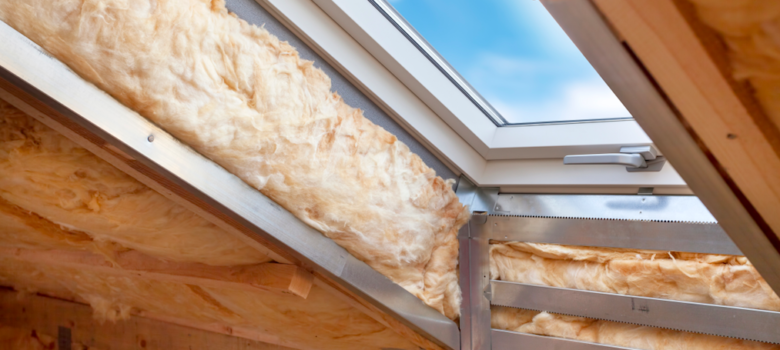
Over the years, the recommended thickness of loft insulation has increased. The reason for the increase is pretty simple – the thicker the layer of loft insulation, the bigger the energy savings!
The Government are very keen for every house in the UK to be have loft insulation where possible, since it helps lower heating demand in these properties. The insulation benefits households through lower energy bills, as well as having a home that stays at a more comfortable temperature for longer.
For the Government, energy efficiency is very important since it means that peak demand (i.e. the time of day when gas/electricity use is at its highest) decreases – since each building requires slightly less energy. This means new power plants don’t need to be built, so some nice cost savings for the Government!
So over the years, the amount of loft insulation recommended by the Government has changed – the table below details how it has changed over the years:
| Year | Recommended thickness of loft insulation |
|---|---|
| 1965 | 25mm |
| 1975 | 60mm |
| 1985 | 100mm |
| 1990 | 150mm |
| 1995 | 200mm |
| 2002 | 250mm |
| 2003 | 270mm |
| 2017 | 350mm? |
You can see from the table that the recommended thickness of loft insulation is currently 270mm. The amount of insulation has not changed over the last 14 years though, so it seems an increase in the recommended amount will most likely come shortly.
The Government try to ensure the correct levels of insulation are used though building regulations (specifically Part L, which you can access by clicking here). This also details the thickness of insulation required for other building elements, like walls and floors. Building regulations are really only relevant when doing new building works though (in the case of loft insulation), so it goes without saying there are going to be homes that don’t have the recommended thickness of loft insulation in their lofts.
How to increase the thickness of loft insulation in your home
The good news is that even if you fall into the camp where you have very little loft insulation, adding additional insulation is very cheap. If you go to a local DIY store, you can normally get loft insulation for about £20 a roll. Obviously the cost is going to add up if you don’t have any loft insulation in place at the moment; but even then it works out at about £6 per m2 to insulate a virgin loft (one with zero existing loft insulation) with 270mm of loft insulation.

In order to insulate the loft, always start as far away from the loft hatch as possible and then work back towards the hatch. There should be no gaps between the top layer of insulation; once this layer has been laid, you should no longer be able to see the joists! You are trying to achieve a seamless ‘blanket’ of insulation across the entire loft.
The rule of diminishing return – loft insulation
So at what point does it become pointless to add more insulation to the existing insulation in the loft? Well obviously extra insulation will always help to lower energy bills, but there is a concept known as the rule of diminishing return that comes into play. Basically this means that the first centimetre of insulation will do more than the next and so on and so on.
The graph below shows this phenomenon – the scale on the left shows the rate of heat loss, so a lower number is better. The reason for mentioning this though is that if you have 150mm of insulation or more already in place, then the energy savings you will generate from adding additional insulation won’t be massive.
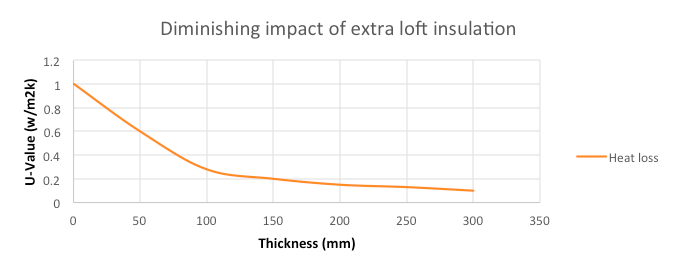
The first 100mm of insulation is where the energy savings are really significant. If it were my home, then if I had less than 150mm of insulation then I probably would look to top up to meet the recommended thickness of loft insulation. If I had more, then I would probably only do this if my energy bills were really high!
Obviously if it is a new build then you have to lay 270mm of insulation in order to meet building regulations, but basically the answer to the question is this: 270mm is the recommended thickness of loft insulation!
Installing loft insulation
Interested in installing loft installation? We have scoured the country for the best tradespeople, so that we can make sure we only recommend those we really trust.
If you would like us to find you a local installer, just fill in the form below and we will be in touch shortly!
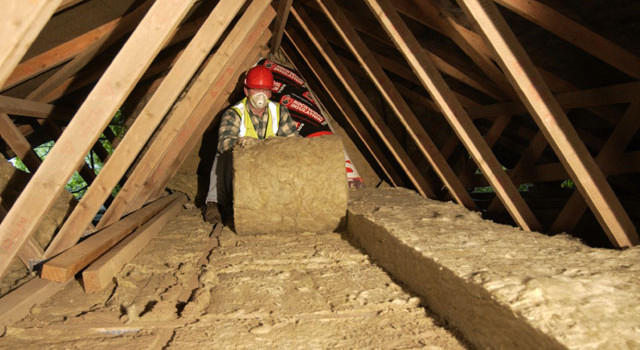



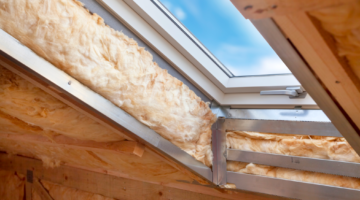

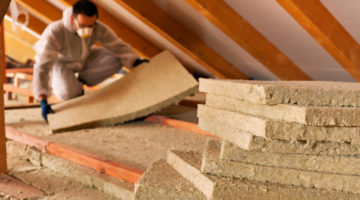






Loft insulation in 2017 being 350 mm, That figure in loft insulation i find ridiculous and the whole point of keeping the home warm by using such thickness is misleading and costing home owners wastage not only in money but also in loft space when having to store some personal belongings, why are people not being advised to insulate their roof as well after all, what point is there in just insulating the loft that only keeps below warm when the loft holds a lot of cold, if people also insulated their roof, their home would remain warmer and that would be the real cost cutting to their utility bills.
Are you a scientist- thought not.
Insulation is mandatory as it keeps room cool in summers and hot in winter according to weather which helps in keeping better environment. Though it is recommended to use loft insulation as it is easy to use and effective way to decrease the heat and it also reduces the cost of heating bills. http://roofsuckers.com.au/
I just want to say that you have a very enjoyable experience as you have mentioned in this blog. Awesome blog and thanks for sharing this wonderful blog for us.
What is not mentioned is the insulation effect of boarding a loft. My joints are 4 inches high and most of the loft has been boarded over to create a walkable floor area. Insulation installed at the time of build (1975) is quite thin and has deteriorated over time. If I added additional insulation to current standard this would be higher than the joists and the boarding. It is therefore not feasable to add any additional material where there is boarding however what is not clear is what degree of insulation is added by the boarding.
I can recommend ‘Loftlegs’ from Wickes that raise the loft boarding by 175mm – very easy to do and not expensive. I’ve used these in two properties.
Perhaps a comment about insulating over electric cables would be useful regarding downrating when buried under insulation?
The chart is very helpful as we are looking at whether it is worth adding additional insulation. I’m not so worried by the cost given how energy prices are rising, but our loft is part boarded and of course full of stuff. Plus working in a loft with old style (not sure if it is glass or rockwool, but it’s nasty to be around) is not a fun job.
We have a 2001 home so it should have 200mm. Reality is it measures more like 150mm and is thrown in in places (not in contact with ceiling below etc). We have downlighters in two bathrooms. Worth mentioning that these need to be handled differently due to the heat they generate. There are currently gaps, but I plan to fit fire-rated lids so that insulation can be tucked up close and any second layer over the top. First step is to insulate the completely uninsulated plywood loft door since that’s quick and easy.
p.s. Meant to say that the current approach to specifying loft insulation thickness rather than a U value is frequently the kind of thing governments get wrong. Specifying a solution rather than a requirement. It stifles innovation.
Can the 270mm, consist of 100mm in the floor and 170mm in the roof ?
I understand that this is not recommended as you are not trying to heat the attic but keep the heat from escaping from the rooms below